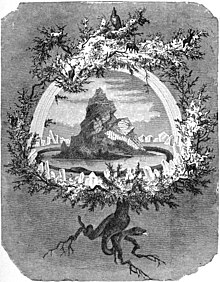Yggdrasil
Yggdrasil
You are part of the
tree of life. You belong. You are part of something bigger than you
realize. You deserve a wonderful life. Your destiny is both fated and
shaped by your will. Be present. Be grounded.
I am
Now,
Holding up
Sending through,
Being with,
Sending forth,
Connected to
Everything.
I am
Life.
Yggdrasil, the tree of
life, is the center of the cosmos. It grows in Asgard, the realm of
the gods. It is also known as askr Yggdrasils, which means “the ash
tree to which Odin's (Yggr's) eight-legged horse, Sleipnir, is tied.”
A mighty ash, Yggdrasil
supports within it's branches and roots the nine worlds of the Norse
cosmos. There, in the various realms, live all beings, including
humans and gods. Yggdrasil grows up from the Well of Wyrd, which is
the flow and living force of destiny that nourishes both the world
tree and life itself. The magic and power that flow through the very
heart of the tree travels along it's roots and branches to each of
the nine worlds. Yggdrasil itself is home to the three Norns, who
carve the fate of all upon the tree, as well as to creatures like
dragons, message-carrying squirrels, and a great eagle.
Yggdrasil is referred to
in many poems in the Eddas. One of the lovelier stanzas comes from
the Völuspá (“Seeress's Prophecy”, in the Codex Regius) reads
thus:
I know that an ash-tree
stands called Yggdrasil,
A high tree, soaked
with shining loam.
From there comes the
dews, which fall in the valley, ever green.
It stands over the well
of fate.
While we are not really
expected to believe that there is a literal tree at the heart of the
Norse cosmos, this beautiful mythos invites to view the action of the
universe in a way that offers insight into our own lives. Yggdrasil
is both central and grounded. It is the symbol of the present, the
now, yet it upholds realms and concepts that flow and change. Ancient
Yggdrasil is strong and reliable, and it has it's own wisdom, as do
the most venerable trees in our modern world.
-------------------------------------
-------------------------------------
Yggdrasil
Yggdrasil (/ˈɪɡdrəsɪl/ or /ˈɪɡdrəzɪl/; from Old Norse Yggdrasill, pronounced [ˈyɡːˌdrasilː]) is an immense mythical tree that connects the nine worlds in Norse cosmology.
Yggdrasil is attested in the Poetic Edda, compiled in the 13th century from earlier traditional sources, and the Prose Edda, written in the 13th century by Snorri Sturluson. In both sources, Yggdrasil is an immense tree that is center to the cosmos and considered very holy. The godsgo to Yggdrasil daily to assemble at their things (aka "governing assemblies"). The branches of Yggdrasil extend far into the heavens, and the tree is supported by three roots that extend far away into other locations; one to the well Urðarbrunnr in the heavens, one to the spring Hvergelmir, and another to the well Mímisbrunnr. Creatures live within Yggdrasil, including the dragon Níðhöggr, an unnamed eagle, and the stags Dáinn, Dvalinn, Duneyrr and Duraþrór.
Conflicting scholarly theories have been proposed about the etymology of the name Yggdrasill, the possibility that the tree is of another species than ash, its connection to the many sacred trees and groves in Germanic paganism and mythology, and the fate of Yggdrasil during the events of Ragnarök.




Comments
Post a Comment